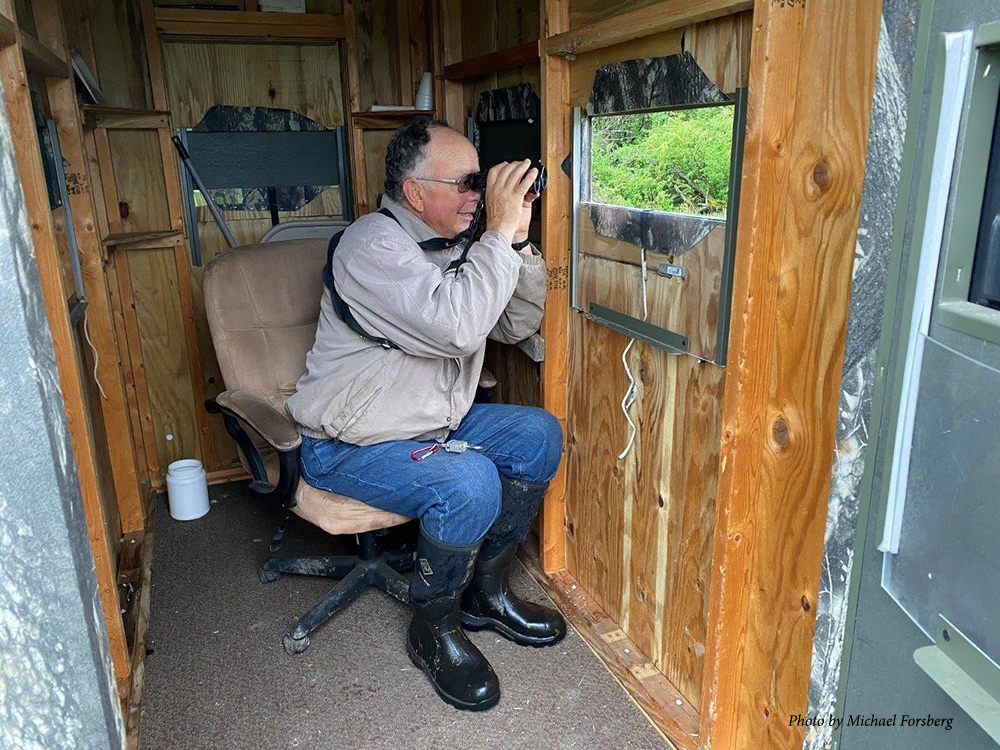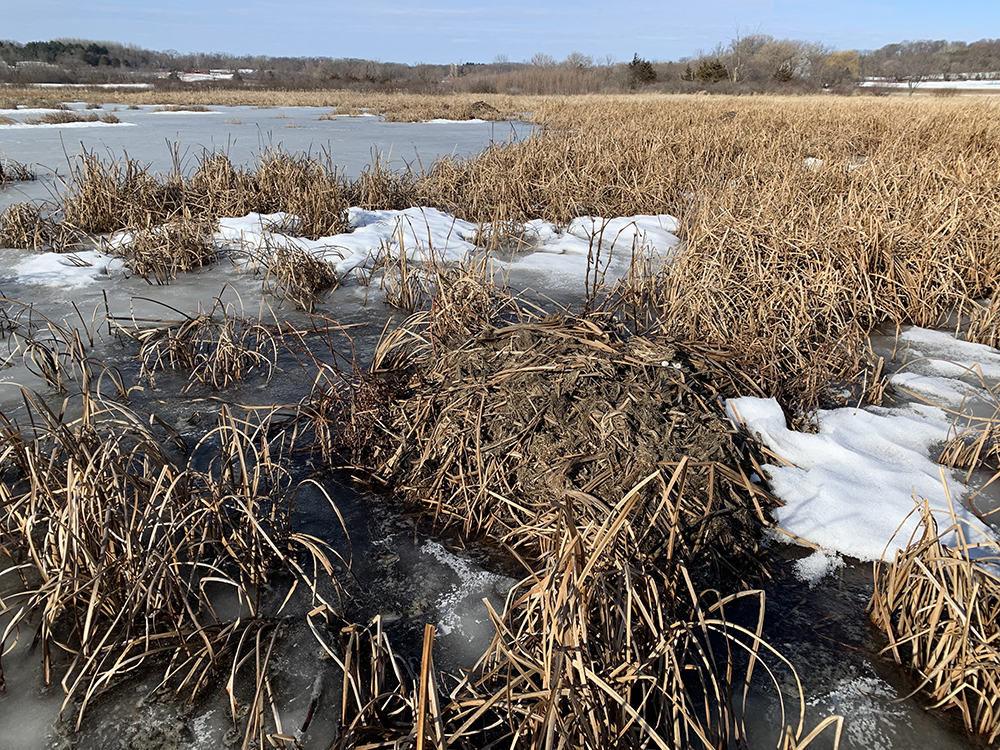As the promise of spring unfolds, our Co-founder George Archibald is returning to a small wetland in Sauk County, Wisconsin, where last year he spent countless hours documenting three young Whooping Cranes and their Sandhill Crane cousins. This year, George will share regular updates on the cranes through our social media and his Travels With George blog series. Read George’s first field entry here.
March 4, 2021
At midday, I checked the marsh where the Whooping Cranes nested last year. Turkeys gobbled from a wood lot to the north. But the marsh was silent, no cranes. As I was arriving home at 6 p.m., the phone was ringing. A neighbor of the marsh enthusiastically announced, “The cranes are back!”

March 5, 2021
6 a.m. The temperature is in the teens. I’m warmly dressed and sitting in a comfortable chair in an elevated deer hunter’s blind, pictured above, with a commanding view of the marsh. The eastern horizon is light orange with pink above. The silence is broken only by the pleasing sound of gurgling water falling from sheets of ice at the source of the creek a few feet west of the blind. Otherwise silence but for the distant drone of the interstate highway a mile away, separated from the marsh by low hills; a reminder of the world of humans.
6:10. Calls of Sandhill Cranes (SC) from the south side of the marsh. Then seven cranes in flight circling the nearby fields. Five continued south. Two with rigid exaggerated wingbeats, a threat flight, split off and land in the southwest corner of the marsh where SC Pair # 1 (SCP) had their breeding territory last year.
6:23. Distant calls of Canada Geese.
6:25. A lone female SC is calling and circling the southern marsh and nearby fields. Two small ducks fly with rapid wing beats. I believe they are Wood Ducks, but it’s perhaps a bit early for them. Then silence.
6:32. Crows calling far away and then a cardinal’s song.
6:33. Glorious sunrise with new light pouring into the marsh. From the southwest where the SCP landed, a lone male SC calls. His call is just the first part of his Unison Call (UC). The male call of the UC (a duet) is a series of long, loud low calls with beak vertically elevated. I find the male in my scope. Separated by some seconds, he repeats the first part of the UC, but his beak is held just above the horizontal. His comb is expanded, and he does a ruffle threat (RT). He seems to be alone. Another male is also calling in like manner from the southeast of the marsh.
7:04. The southwest male stops calling and preens.
7:07. The southwest male starts calling again. While he calls, I count 16 muskrat mounds that peak above the surrounding vegetation. The majority of them are in a sedge-covered area of the marsh where the Whooping Cranes (WC) nested last year at the east end of the north pond (NP). Turkeys are calling from the forests and perhaps fields north of the marsh.
7:16 – 7: 53. A lone female SC is calling from the south field. Each call is a long broken rattle at a high pitch. She appears to be calling in response to the southwest male. I get her in my scope. She is walking slowly across the field toward the male and calling continually. She stops and emits the female-unique introductory call to the UC, then continues walking toward the male. Suddenly the male emits several calls of his part of the UC. His beak is vertical. Some moments pass. The female in threat flight lands near the male. Both birds are silent, looking at one another. The female walks toward the male, who does an RT and walks towards the east. Suddenly to my surprise, another male in threat posture appears with the scope’s view. He had perhaps flown in from the southeast unknown to me.
7:53 – 8:30. During this period, the two males and the single female follow one another east, then west, then back east, walking in rigid threat walk (TW), and silent but for the occasional male call of the first part of his UC. If a female is serious about pairing with a male, she will emit the introduction to the UC. But she remains silent and struts around with the males. Then a third and quite submissive bird appears walking in from the west. He is immediately attacked by one of the males and retreats a short distance. The newcomer just observes the other three but does not participate in their ritual. Each of the three displaying birds spends a few moments rigidly standing on the only muskrat mound in that area. Twice one of the displaying males performs the start of the dance with head arched rapidly backward and snapping at the air. Once the female with her back to an approaching male spread her wings for a few seconds in precopulatory displays. Then she flew away to the northeast will continually emitting a flight call. Obviously, whatever she wanted, those three males failed the test. Perhaps she was looking for a more experienced male. Such is today’s mystery.

8:30 – 9:00. After the female departed, the lone male that had not displayed suddenly started threat walking with the other two males. One of the latter males attacked that male. There was a brief fight followed by more threat walking. The treat displays continued until I left the blind to walk over the fast-melting ice to photograph last year’s WC nest. The muskrats had added a bit of sedge and some dropping to the top of it.
 Story submitted by George Archibald, Co-founder and Senior Conservationist. Click here to learn more about our work in North America.
Story submitted by George Archibald, Co-founder and Senior Conservationist. Click here to learn more about our work in North America.
